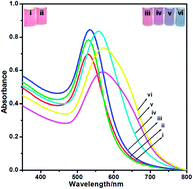Tunable functionality and nanogeometry in tetrahydrofuran hydroperoxide and 3-aminopropyl-trimethoxysilane mediated synthesis of gold nanoparticles; functional application in glutathione sensing
Abstract
Substantive research on controlled synthesis of noble metal nanoparticles displaying tunable functionality and nanogeometry has been a challenging requirement. We report herein a process involving the active role of tetrahydrofuran hydroperoxide (THF-HPO) and 3-aminopropyltrimethoxysilane (3-APTMS) that allows controlled synthesis of functional gold nanoparticles (AuNPs) with the following major findings: (1) an increase in 3-APTMS concentrations causes an increase in size whereas the same for THF-HPO shows the reverse effect; (2) different sizes of AuNPs at the same concentration of 3-APTMS can be made by controlling THF-HPO; (3) addition of 3-APTMS even after AuNPs synthesis allow control over nanogeometry; (4) formation of γ-butyrolactone (GBL) during nanoparticle synthesis which itself participates in AuNPs synthesis. Furthermore, the functionality and nanogeometry of the as synthesized AuNPs are utilized in glutathione sensing justifying the pivotal role of functionality as compared to nanogeometry.


 Please wait while we load your content...
Please wait while we load your content...